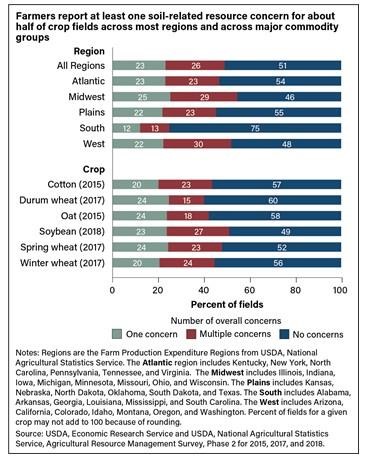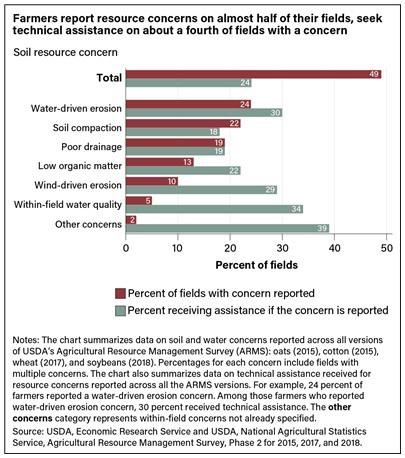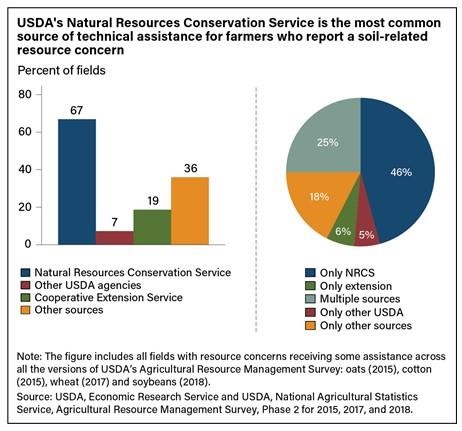By Andrew B. Rosenberg and Steven Wallander
When natural resources degrade to the degree that their intended use is impaired, then a given land parcel is said to have a “resource concern.” Soil resource concerns, such as soil erosion or low organic matter, can result from geographic factors as well as past and ongoing management decisions. In the long run, soil concerns can reduce agricultural productivity and profitability. Soil concerns also can exacerbate off-farm impacts of farming and ranching, such as downstream water pollution. Using a nationally representative sample of land from the 2017 National Resources Inventory (NRI), the USDA, Natural Resources Conservation Service (NRCS) found that 18 percent of cropland acreage has water erosion, and 14 percent has a wind-erosion concern.
Highlights:
Soil resource concerns can reduce farm productivity and profitability on farm fields, as well as exacerbate off-farm impacts of agriculture. Farmers growing oats and cotton in 2015, wheat in 2017, and soybeans in 2018 reported having at least one within-field resource concern on 49 percent of their fields.
Water-driven erosion is the most prevalent farmer-reported resource concern, followed by soil compaction, poor drainage, and low organic matter.
Farmers received technical assistance with production practices on 24 percent of their fields with self-reported resource concerns. USDA’s Natural Resources Conservation Service was the most common source of technical assistance.
Producers may be able to address on-field soil resource concerns on their own through management practices, such as planting cover crops or conservation buffers. However, in cases where producers lack the information or financial means to implement expensive practices, they may request technical or financial assistance. Conservation technical assistance is a service offered by USDA that provides expertise on how to address conservation issues. USDA allocates nearly $2 billion a year to conservation technical assistance, largely administered by the NRCS, both as a standalone resource and to support financial assistance programs. At the core of these programs is the resource assessment and planning process in which NRCS employees work with producers to identify and address resource concerns. Other prominent sources of technical assistance include State agencies, conservation districts, technical service providers, and land grant university cooperative extension agents.
A recent USDA, Economic Research Service (ERS) study considered how many farmers who reported having resource concerns on fields in several commodities also received technical assistance in addressing the concerns. The study analyzed data collected from USDA’s Agricultural Resource Management Survey (ARMS) for fields growing oats and cotton in 2015, wheat (including winter, spring, and durum) in 2017, and soybeans in 2018. The analysis focused on seven resource concerns primarily related to soil and water on cropland: water-driven erosion, wind-driven erosion, soil compaction, poor drainage, low organic matter, within-field water quality concerns, and “other” concerns. These roughly correspond with 31 specific soil and water resource concerns identified by NRCS, among a total of 47 specific concerns, that form the basis of conservation planning.
In ARMS, farmers were asked (1) to self-report the presence of these seven concerns on their fields and (2) whether they had received technical assistance related to those concerns and from which sources they received assistance. The study found that across all represented fields, farmers reported at least one soil resource concern on 49 percent of their fields and two or more on 26 percent of their fields. While conservation technical assistance is a tool to help address resource concerns, 76 percent of farmers who reported a soil-related resource concern on their field had not received technical assistance.
Soybean Farmers Reported the Most Soil Concerns Among Selected Crops
The percentages of fields with at least one self-reported resource concern varied across crops, with farmers growing soybeans reporting concerns most frequently (about 51 percent had at least one concern). This was followed by spring wheat (about 48 percent of fields), winter wheat (44 percent), cotton (43 percent), oats (42 percent) and durum wheat (about 40 percent). Differences in the way crops are managed and differences in their production environments may account for some of the differences in the frequency of concerns across crops. Farmers may choose to grow a crop based on factors such as certain soil properties that also influence the likelihood of having resource concerns.
Farmers in the Midwest and West were most likely to report at least one resource concern. In the Midwest—the region with the greatest number of fields for the represented crops—farmers reported at least one resource concern on 54 percent of their fields, and multiple concerns on 29 percent of their fields. In the West, 52 percent of represented fields had at least one concern, and 30 percent had multiple concerns. In the Plains—the second largest region by the number of fields—farmers reported that 45 percent of the represented fields had at least one concern, and 23 percent had multiple concerns. Farmers in the South identified resource concerns for 25 percent of their fields, and they reported multiple concerns on 13 percent of fields. The lower rates of resource concerns in the South align with other studies. For example, USDA’s Soil and Water Resources Conservation Act (RCA) Appraisal found lower rates of water-driven erosion in the South.

Embed this chart
Download larger size chart (1025 pixels by 1311, 72 dpi)
The Most Prevalent Farmer-Reported Soil Resource Concerns Are Water-Driven Erosion and Soil Compaction
Water-driven erosion and soil compaction were the two most reported resource concerns. Farmers reported water-driven erosion on 24 percent of all represented fields and soil compaction on 22 percent of fields. Poor drainage was also commonly reported, affecting 19 percent of fields represented. Other resource concerns were less commonly reported. For example, farmers reported wind-driven erosion on 10 percent of represented fields and low organic matter on nearly 13 percent of fields. The least common resource concern was within-field water quality, with farmers identifying the concern for 5 percent of fields. Finally, farmers reported “other concerns” on 2 percent of fields.

Embed this chart
Download larger size chart (1025 pixels by 1161, 72 dpi)
Rates of Conservation Technical Assistance Vary Across Soil-Related Resource Concerns
Across all resource concerns, farmers received technical assistance on 24 percent of fields on which they reported at least one concern. Moreover, the percentage of farmers who received technical assistance varied considerably across concerns. For example, farmers received technical assistance on 30 percent of fields reported to have water-driven erosion and on 29 percent of fields reported to have wind-driven erosion. In contrast, although soil compaction was reported nearly as often as water erosion, farmers received technical assistance on only 18 percent of the represented fields that reported having a compaction concern. Similarly, only 19 percent of fields with poor drainage received technical assistance. Among fields with low organic matter, 22 percent received assistance. Finally, 34 percent of fields with self-reported water quality concerns received technical assistance, as did 39 percent of fields with other concerns.
Rates of assistance could be affected by whether and how the concern affects productivity. Differences in receipt of technical assistance across concerns may also reflect differences in priority resource concerns for financial assistance programs, which rely on technical assistance as part of the process of prioritizing funding. For example, ERS’ 2019 Agricultural Resources and Environmental Indicators report found that among contracts enrolled in NRCS’ Environmental Quality Incentives Program, 19 percent of funds were obligated to soil erosion concerns, and 10 percent of funds went to soil condition concerns such as compaction and low organic matter. Finally, some combinations of concerns often may be assessed together; consequently, farmers with concerns that tend to occur together may be more likely to receive assistance.
NRCS Was the Most Common Source of Technical Assistance To Address Resource Concerns
Farmers reporting resource concerns on their fields received assistance from multiple sources. The NRCS was the largest source of technical assistance, although farmers also received assistance from other USDA agencies, the Cooperative Extension Service, and non-USDA entities such as State agencies and conservation districts. Of all fields receiving assistance, 67 percent received it from NRCS, and for 46 percent, NRCS was the sole source of assistance. Nineteen percent of represented fields received assistance from the Cooperative Extension Service, and 7 percent received assistance from a USDA agency other than NRCS. In addition, farmers received technical assistance from sources such as conservation districts or State agencies on 36 percent of represented fields. One-fourth received assistance from multiple sources.

Embed this chart
Download larger size chart (1025 pixels by 951, 72 dpi)
Source : usda.gov